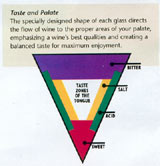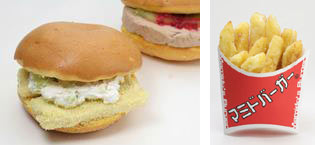
 The latest scandal in the world of French gourmet cuisine: the use of artificial bottled flavors (aka arômes artificiels) to substitute for high-end ingredients such as truffles, wild mushroom, caviar, prawn, crab, shallot, scallop, saffron, and even wine. The London Times reports:
The latest scandal in the world of French gourmet cuisine: the use of artificial bottled flavors (aka arômes artificiels) to substitute for high-end ingredients such as truffles, wild mushroom, caviar, prawn, crab, shallot, scallop, saffron, and even wine. The London Times reports:  Todd emailed me a link to this Phoenix New Times article about rogue chef "Kaz" Yamamoto, whose specialty is creating dishes from "meat, game and vegetation that's considered off limits, immoral or even illegal." We're talking about dishes such as Tenderloin of Bichon Frise, monkey brain stew, Arizona saguaro cactus salad, Yosemite brown bear, rhino genitals, giraffe tongue, Sea World sea lion (supposedly obtained by bribing a Sea World employee), etc. Yamamoto even claims to serve human flesh, obtained by paying Mexican immigrants a handsome sum for their kidney, arm, or leg. These delicacies are all served to a rich and powerful clientele who have a taste for forbidden food.
Todd emailed me a link to this Phoenix New Times article about rogue chef "Kaz" Yamamoto, whose specialty is creating dishes from "meat, game and vegetation that's considered off limits, immoral or even illegal." We're talking about dishes such as Tenderloin of Bichon Frise, monkey brain stew, Arizona saguaro cactus salad, Yosemite brown bear, rhino genitals, giraffe tongue, Sea World sea lion (supposedly obtained by bribing a Sea World employee), etc. Yamamoto even claims to serve human flesh, obtained by paying Mexican immigrants a handsome sum for their kidney, arm, or leg. These delicacies are all served to a rich and powerful clientele who have a taste for forbidden food.  A rare heart-shaped potato has been found by Linda Greene of Moon Township, Pa. She found it in a sack of potatoes back in February and emailed the Idaho Potato Commission about it in March. For some reason it's only making headlines now. What makes the discovery of the potato strange is that irregularly shaped potatoes are supposed to be removed during the sorting process and used for french fries. The potato commission president said: "I would guarantee someone saw it and thought, 'This is cool, we'll let this go through.'... Typically, unique shapes will go into processing _ dehydrated or cut up into french fries." To those who suggest the love spud is a plant (pun intended), being used by the commission to drum up publicity, the commission president says, "We didn't plant it. We'll have to start sorting for heart-shaped potatoes." (Thanks to Big Gary for the story)
A rare heart-shaped potato has been found by Linda Greene of Moon Township, Pa. She found it in a sack of potatoes back in February and emailed the Idaho Potato Commission about it in March. For some reason it's only making headlines now. What makes the discovery of the potato strange is that irregularly shaped potatoes are supposed to be removed during the sorting process and used for french fries. The potato commission president said: "I would guarantee someone saw it and thought, 'This is cool, we'll let this go through.'... Typically, unique shapes will go into processing _ dehydrated or cut up into french fries." To those who suggest the love spud is a plant (pun intended), being used by the commission to drum up publicity, the commission president says, "We didn't plant it. We'll have to start sorting for heart-shaped potatoes." (Thanks to Big Gary for the story)
 Speaking of fake Irish bars, now it's possible to have an instant fake British pub, anywhere you like. It's advertised as "the Worlds first fully functioning Mobile Inflatable Pub." This comes from the same people who brought us the world's first inflatable church. Ideally it should come with a bartender who fakes a British accent.
Speaking of fake Irish bars, now it's possible to have an instant fake British pub, anywhere you like. It's advertised as "the Worlds first fully functioning Mobile Inflatable Pub." This comes from the same people who brought us the world's first inflatable church. Ideally it should come with a bartender who fakes a British accent.
 I've posted before about theories that microwaved food is bad for you, but this is slightly different. Some guy has posted pictures of his granddaughter's science fair project in which she tested the effect microwaved water would have on a plant. The result: the plant died. (Yes, the water had been cooled before she watered the plant with it.) But the plant given water that had been boiled on a stove did just fine. So what does this prove? That microwaved water is toxic? Not necessarily. The guy notes:
I've posted before about theories that microwaved food is bad for you, but this is slightly different. Some guy has posted pictures of his granddaughter's science fair project in which she tested the effect microwaved water would have on a plant. The result: the plant died. (Yes, the water had been cooled before she watered the plant with it.) But the plant given water that had been boiled on a stove did just fine. So what does this prove? That microwaved water is toxic? Not necessarily. The guy notes: I've found another beer to add to my list of hoax-themed beers: Boonville Beer. Its label shows a picture of a bear with antlers. I was having a bottle of this beer (the outmeal stout) out on the patio this afternoon, saw the antlered bear, and got curious. A quick internet search revealed that the creature isn't actually a bear. The Anderson Valley Brewing Company website explains:
I've found another beer to add to my list of hoax-themed beers: Boonville Beer. Its label shows a picture of a bear with antlers. I was having a bottle of this beer (the outmeal stout) out on the patio this afternoon, saw the antlered bear, and got curious. A quick internet search revealed that the creature isn't actually a bear. The Anderson Valley Brewing Company website explains: A British mail-order chili firm, Peppers by Post, claims that it has developed the hottest chili in the world. Its website states:
A British mail-order chili firm, Peppers by Post, claims that it has developed the hottest chili in the world. Its website states: One of the many catalogs I receive is the Wine Enthusiast. On the inside cover of the catalog I received last week is a description of Symphony Stemware wine glasses which are supposedly "designed and shaped to enhance the best characteristics of every wine." Accompanying this claim is a map of the tongue with the following caption:
One of the many catalogs I receive is the Wine Enthusiast. On the inside cover of the catalog I received last week is a description of Symphony Stemware wine glasses which are supposedly "designed and shaped to enhance the best characteristics of every wine." Accompanying this claim is a map of the tongue with the following caption:
 On Google video there are a couple of commercials from the early 80s touting a weight-loss product called Ayds. (An Ayds radio commercial can be heard here.) The name of the product is so unfortunate, that it makes the ads sound like Saturday Night Live skits, with lines such as: "Ayds helps you control your appetite so you lose weight... Why take diet pills when you can enjoy Ayds?... Ayds helps you lose weight safely and effectively!"
On Google video there are a couple of commercials from the early 80s touting a weight-loss product called Ayds. (An Ayds radio commercial can be heard here.) The name of the product is so unfortunate, that it makes the ads sound like Saturday Night Live skits, with lines such as: "Ayds helps you control your appetite so you lose weight... Why take diet pills when you can enjoy Ayds?... Ayds helps you lose weight safely and effectively!" For Valentine's Day my wife and I went to a restaurant called Green Tomato and had a great meal which included ravioli in a mustard cream sauce, green tomato soup, and chicken stuffed with mascarpone and spinach. But apparently, if this picture which is going around can be believed, the Valentine's Day dinner at the White House was quite a bit fancier than what I had. I don't see any good reason why this White House menu shouldn't be real. After all, the White House does employ a master chef. But it is possible that someone created this menu as a kind of fantasy meal. I checked out the White House website, but unfortunately no dinner menus were posted there. (via Martini Republic)
For Valentine's Day my wife and I went to a restaurant called Green Tomato and had a great meal which included ravioli in a mustard cream sauce, green tomato soup, and chicken stuffed with mascarpone and spinach. But apparently, if this picture which is going around can be believed, the Valentine's Day dinner at the White House was quite a bit fancier than what I had. I don't see any good reason why this White House menu shouldn't be real. After all, the White House does employ a master chef. But it is possible that someone created this menu as a kind of fantasy meal. I checked out the White House website, but unfortunately no dinner menus were posted there. (via Martini Republic)